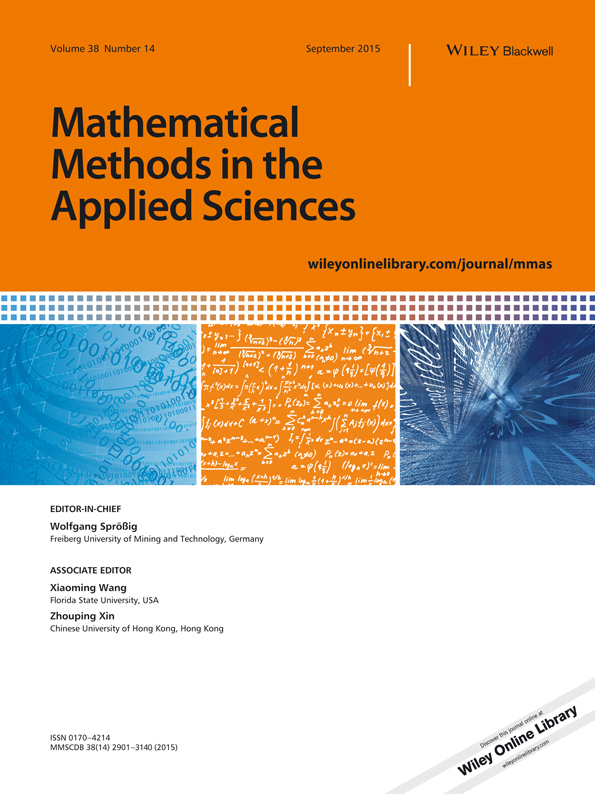Bifurcation analysis of a diffusive predator–prey system with a herd behavior and quadratic mortality
Zhou Xu
Department of Mathematics, Tongji University, Shanghai, 200092 China
Search for more papers by this authorCorresponding Author
Yongli Song
Department of Mathematics, Tongji University, Shanghai, 200092 China
Correspondence to: Yongli Song, Department of Mathematics, Tongji University, Shanghai 200092, China
E-mail: [email protected]
Search for more papers by this authorZhou Xu
Department of Mathematics, Tongji University, Shanghai, 200092 China
Search for more papers by this authorCorresponding Author
Yongli Song
Department of Mathematics, Tongji University, Shanghai, 200092 China
Correspondence to: Yongli Song, Department of Mathematics, Tongji University, Shanghai 200092, China
E-mail: [email protected]
Search for more papers by this authorAbstract
In this paper, a diffusive predator–prey system, in which the prey species exhibits herd behavior and the predator species with quadratic mortality, has been studied. The stability of positive constant equilibrium, Hopf bifurcations, and diffusion-driven Turing instability are investigated under the Neumann boundary condition. The explicit condition for the occurrence of the diffusion-driven Turing instability is derived, which is determined by the relationship of the diffusion rates of two species. The formulas determining the direction and the stability of Hopf bifurcations depending on the parameters of the system are derived. Finally, numerical simulations are carried out to verify and extend the theoretical results and show the existence of spatially homogeneous periodic solutions and nonconstant steady states. Copyright © 2014 John Wiley & Sons, Ltd.
References
- 1Lotka AJ. Elements of Physical Biology. Williams and Wilkins: New York, 1925.
- 2Volterra V. Variazioni e fluttuazioni del numero d'individui in specie conviventi. Mem Acad Lincei Roma 1926; 2: 31–113.
- 3Malchow H, Petrovskii SV, Venturino E. Spatiotemporal Patterns in Ecology and Epidemiology: Theory, Models, and Simulation. Chapman Hall/CRC Press: Boca Raton, 2008.
- 4Murray JD. Mathematical Biology. Springer Verlag: New York, 1989.
10.1007/978-3-662-08539-4 Google Scholar
- 5Holling CS. The functional response of predators to prey density and its role in mimicry and population regulation. Memoirs of the Entomological Society of Canada 1965; 97: 5–60.
10.4039/entm9745fv Google Scholar
- 6Andrews JF. A mathematical model for the continuous culture of microorganisms utilizing inhibitory substrates. Biotechnology and Bioengineering 1968; 10: 707–723.
- 7Tanner JT. The stability and the intrinsic growth rates of prey and predator populations. Ecology 1975; 56: 855–867.
- 8Braza PA. The bifurcations structure for the Holling–Tanner model for predator–prey interections using two-timing. SIAM Journal on Applied Mathematics 2003; 63: 889–904.
- 9Beddington JR. Mutual interference between parasites or predators and its effect on searching efficiency. Journal of Animal Ecology 1975; 44: 331–340.
- 10DeAngelis DL, Goldstein RA, O'Neill RV. A model for trophic interaction. Ecology 1975; 56: 881–892.
- 11Zhang XC, Sun GQ, Jin Z. Spatial dynamics in a predator–prey model with Beddington–DeAngelis functional response. Physical Review E 2012; 85:0219241-02192414.
- 12Arditi R, Ginzburg LR. Coupling in predator–prey dynamics: ratio-dependence. Journal of Theoretical Biology 1989; 139: 311–326.
- 13Kooij RE, Zegeling A. A predator–prey model with Ivlev's functional response. Journal of Mathematical Analysis and Applications 1996; 198: 473–489.
- 14Ajraldi V, Pittavino M, Venturino E. Modeling herd behavior in population systems. Nonlinear Analysis: Real World Applications 2011; 12: 2319–2338.
- 15Braza PA. Predator–prey dynamics with square root functional responses. Nonlinear Analysis: Real World Applications 2012; 13: 1837–1843.
- 16Venturino E, Petrovskii S. Spatiotemporal behavior of a prey–predator system with a group defense for prey. Ecological Complexity 2013; 14: 37–47.
- 17Baurmann M, Gross T, Feudel U. Instabilities in spatially extended predator–prey systems: spatio-temporal patterns in the neighborhood of Turing–Hopf bifurcations. Journal of Theoretical Biology 2007; 245: 220–229.
- 18Brentnall SJ, Richards KJ, Brindley J, Murphy E. Plankton patchiness and its effect on larger-scale productivity. Journal of Plankton Research 2003; 25: 121–140.
- 19Fulton EA, Smith ADM, Johnson CR. Mortality and predation in ecosystem models: is it important how these are expressed?Ecological Modelling 2003; 169: 157–178.
- 20Yuan SL, Xu CQ, Zhang TH. Spatial dynamics in a predator–prey model with herd behavior. CHAOS 2013; 23:0331021-03310210.
- 21Yi FQ, Wei JJ, Shi JP. Bifurcation and spatiotemporal patterns in a homogeneous diffusive predator–prey system. Journal of Differential Equations 2009; 246: 1944–1977.
- 22Zhang JF, Li WT, Yan XP. Hopf bifurcation and turing instability in spatial homogeneous and inhomogeneous predator–prey models. Applied Mathematics and Computation 2011; 218: 1883–1893.
- 23Wang JF, Shi JP, Wei JJ. Dyanmics and pattern formation in a diffusive predator–prey system with strong Allee effect in prey. Journal of Differential Equations 2011; 251: 1276–1304.
- 24Yan XP. Stability and Hopf bifurcation for a delayed prey–predator system with diffusion effects. Applied Mathematics and Computation 2007; 192: 552–566.
- 25Zuo WJ, Wei JJ. Stability and Hopf bifurcation in a diffusive predatory–prey system with delay effect. Nonlinear Analysis: Real World Applications 2011; 12: 1998–2011.
- 26Zuo WJ, Wei JJ. Stability and bifurcation in a ratio-dependent Holling-III system with diffusion and delay. Nonlinear Analysis: Modelling and Control 2014; 19: 132–153.
- 27Chang XY, Wei JJ. Stability and Hopf bifurcation in a diffusive predator–prey system incorporating a prey refuge. Mathematical biosciences and engineering 2013; 10: 979–996.
- 28Pang PYH, Wang MX. Qualitative analysis of a ratio-dependent predator prey system with diffusion. Proceedings of the Royal Society of Edinburgh: Section A Mathematics 2003; 133: 919–942.
- 29Aly S, Kim I, Sheen D. Turing instability for a ratio-dependent predator–prey model with diffusion. Applied Mathematics and Computation 2011; 217: 7265–7281.
- 30Banerjee M. Self-replication of spatial patterns in a ratio-dependent predator–prey model. Mathematical and Computer Modelling 2010; 51: 44–52.
- 31Banerjee M, Petrovskii S. Self-organised spatial patterns and chaos in a ratio-dependent predator–prey system. Theoretical Ecology 2011; 4: 37–53.
- 32Song YL, Zou XF. Spatiotemporal dynamics in a diffusive ratio-dependent predator–prey model near a Hopf-Turing bifurcation point. Computers Mathematics with Applications 2014; 67: 1978–1997.
- 33Song YL, Zou XF. Bifurcation analysis of a diffusive ratio-dependent predator–prey model. Nonlinear Dynamics 2014. DOI: 10.1007/s11071-014-1421-2.
- 34Hassard BD, Kazarinoff ND, Wan YH. Theory and Applications of Hopf Bifurcation. Cambridge University Press: Cambridge, 1981.




